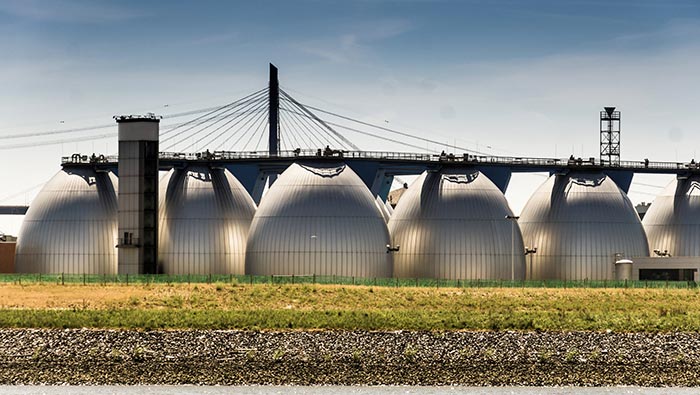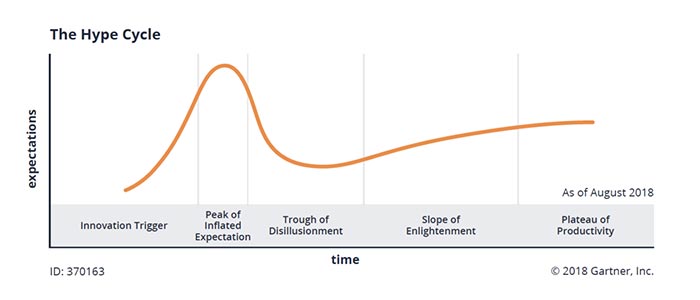Sustainability Strategy – For the Now, the Near, and the Far

Don’t believe the hype: proven technologies like on-site microgrids offer facilities the most effective path forward for meeting their emission goals today and in the future.
Does your sustainability strategy work for “the near, the now, and the far?” This idea, popularized by Jim Hackett, former Ford Motors CEO, calls on companies facing disruption to work simultaneously in three dimensions: the immediate, near-term, and long-term.
For facilities formulating an energy plan, the long-term goal is 100% renewable energy, but they must choose technology that is realistic today. In-development green technologies are often overhyped — as in, they may not be feasible solutions even five or ten years out. Facilities need to evaluate what technology works today but can also support the site’s long-term goals.
In this context, it is easy to get swept up in the hype around the latest and greatest technology options that promise more than they are ever likely to deliver. Many of these are at least a decade from viability, if they do come to fruition. The Gartner Hype curve describes a familiar pattern of “hype and disillusionment” around such technological developments.
In fact, many energy solutions do not live up to the initial hype. Too many technologies and their associated startups inspire initial investments, but turn out to be economically non-viable and leave stranded assets behind when they fail. For instance, Nikola motors raised $230 million in funding in 2019 for a hydrogen fuel cell truck and appeared on a promising trajectory, but its technology claims were unsupported by reality. Despite its early-mover advantage, the lack of engineering progress doomed its efforts.
Facilities Feel Pressure to Act Now
An increasing number of facilities have committed to reaching zero carbon quickly, but most have limited ideas how to get started on that path.
Pushed by climate change, societal pressure, and investor preference, nearly 300 organizations have joined RE100 to target 100% renewable energy by 2050. A March 2021 report from the World Energy Council surveyed 2,500 global energy leaders and found they had an ambitious drive to “decarbonize energy, secure carbon neutrality and avoid climate change catastrophe.”
At the same time, most facilities lack realistic plans for how to reach these targets in this ambitious timeframe. Facilities may not know what options are realistic, affordable, and effective enough to choose today.
The Gartner Hype Curve Warns of Financial Risk
The Gartner Hype Curve suggests that today’s most “cutting-edge” energy solutions may actually pose a financial risk.
In this context, it is easy to get swept up in the hype around the latest and greatest technology options that promise more than they are ever likely to deliver. Many of these are at least a decade from viability if they do come to fruition. The Gartner Hype curve describes a familiar pattern of “hype and disillusionment” around such technological developments.
In fact, many energy solutions do not live up to the initial hype. Too many technologies and their associated startups inspire initial investments, but turn out to be economically non-viable and leave stranded assets behind when they fail. For instance, Nikola motors raised $230 million in funding in 2019 for a hydrogen fuel cell truck and appeared on a promising trajectory, but its technology claims were unsupported by reality. Despite its early-mover advantage, the lack of engineering progress doomed its efforts.
A Flexible Foundation Is the Way Forward
Combined heat and power (CHP) microgrids offer significant emission reductions today, and can be easily adjusted to incorporate biogas, hydrogen, or carbon capture technologies in the near-term.
Making a rash investment poses risk, but inaction has its own lost opportunity costs. Facilities must take action, with a technology that works for today and tomorrow. Cogeneration systems allow facilities to set a strong yet flexible foundation for emission reductions now and in the future. A CHP microgrid offers active sustainability because it can reduce a facility’s emissions by 30-40% versus the utility. Installing a CHP system is also an opportunity for passive sustainability, in the form of upgrading the site’s old and inefficient equipment.
Cogeneration is a proven solution for the “now” that offers real, on-site results and reduces strain on the local grid. CHP is also a strong foundation for the near term, as fuel sources increasingly incorporate biogas and hydrogen, further reducing carbon intensity, and for the far-term, as active carbon capture and sequestration technology become economically viable and widely available.
As your long-term partner, Unison Energy helps cut your emissions today using cogeneration and works with you to integrate new technologies as they become available. Click here to contact a Unison Energy representative.
Energy insights, delivered
Subscribe for more content.
Related Blogs

The Energy Crisis in Healthcare: Mitigating Financial Losses Through Reliable Power Solutions
Deadlines for the Inflation Reduction Act
Canadian Carbon Reduction Incentives: What You Should Know
